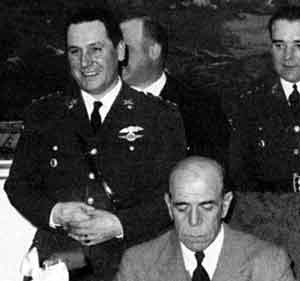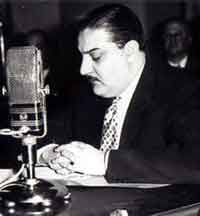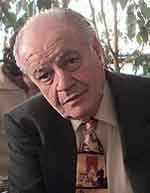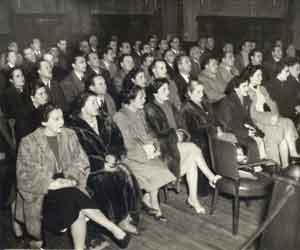|

Juan Perón and Edelmiro
Farrell in 1944
(Archivo General de la Nación) |
In this position, Farrell was among the group of officers
that supported Col. Juan D. Perón's raise to Argentine
presidency. Farrell's identification with Perón among the
working classes could be gauged on 17 October 1945,
when a jubilant crowd of 300,000 descamisados began
singing "Farrell y Perón / un solo corazón".
[9]
Furthermore, before Perón's famous speech on that opportunity,
Farrell addressed the labourers "with the deep emotion that the
president of this nation feels before a working crowd like this
one. Once again, here is the man who thanks to his
dedication and determination has managed to win everybody's
heart, Col. Perón." (La Nación, 18 October 1946). During
the elections of 24 February 1946, Edelmiro Farrell ironed out
any difficulties Perón could encounter to reach the first
office. A series of government decrees were approved by Farrell
(allegedly under Perón's influence), by which there were
increases in general salaries, paid holidays to most labourers,
redundancy pays, as well as the creation of a mandatory
Christmas bonus. On 4 June 1946 Juan D. Perón was sworn
president by Edelmiro Farrell.
Juan Isaac Cooke (1895-1957) is another Irish Argentine
who supported and actively worked with the Peronist rule in
the early period. A distinguished Radical leader in Buenos
Aires province, during the World War II Juan Cooke advocated the
support to the Allies. Within the goal to involving Radical
politicians in the June Revolution, Edelmiro Farrell appointed
Juan Cooke as minister of foreign affairs. Consequently, Cooke was
banished from the Radical Party. In 1945, Juan Cooke, Eduardo
O'Donnell and other
Radical leaders founded the Unión Cívica Radical "Junta
Renovadora". [10]
This was one of the three groups supporting Juan Perón's
candidature in 1946 elections. For this reason the opposition
derogatorily labelled Junta Renovadora as "The
Collaborationists" (in association with the Nazi supporters in
Europe). Juan Isaac Cooke was elected MP to the national
parliament and later ambassador to Brazil.
|

John William Cooke (1919-1968)
(Archivo General de la Nación) |
Better known than Juan Isaac Cooke is his son, John
William Cooke (1919-1968). After graduating at the school of
law, John W. Cooke began his political career at twenty-five.
Together with his father, he was elected MP for UCR Junta
Renovadora. In spite of John W. Cooke's inexperience he was
appointed to chair the parliamentary committee of constitutional
affairs. In addition to this, John Cooke was the secretary of
the Peronist group of MPs and later, member of Partido Unico's
executive committee. [11]
In his speeches and writings Cooke maintained a nationalist and
anti-imperialist stance. He did not accept Perón's offer in 1955
to chair the technical affairs secretariat, and was appointed
instead to audit the Peronist Party in the city of Buenos
Aires. When the Peronist administration was challenged by
rumours of a coup d'état, John Cooke boldly suggested to create
armed militias so as to involve the people in the regime's
defence. After the coup of 1955 that toppled Perón's government
(the so-called Revolución Libertadora), J.W. Cooke was appointed
Perón's only proxy and he would "entitle compañero John
William Cooke, who is now jailed for his loyalty to our cause
and our movement, to represent myself in any circumstance or
political activity. His decision will be my decision, and his
word will be my word. I acknowledge Mr. Cooke as the only person
with powers to chair the Peronist people in and outside of
Argentina. His decisions will bear the same value as my own
decisions. In case I die I hereby delegate my powers on Mr.
Cooke." Once Perón was exiled in Madrid, John William Cooke was
the most important leader of Resistencia Peronista, the movement
created to resist the military rule. Cooke's ideology strongly
influenced the leftist groups within Peronism, as well as another
militant with Irish origins, Rodolfo Walsh (1927-1977), who in
the 1970s would be a high rank officer of Montoneros, the
Peronist armed guerrilla.

Guillermo P. Kelly (1922-2005)
(La Nación, 1 July 2005) |
Other Irish-Argentine Peronists include Alberto Rocamora
O'Gorman (1912-2004), a great nephew of ill-fated Camila
O'Gorman. [12] Rocamora O'Gorman developed a long career in politics and as
university professor. In 1946 he was elected to MP to the
national parliament, and in 1952 had a legal power of attorney
from the Eva Perón Foundation. Two years later he was appointed
to the chairmanship of the Lower House. Later in 1974, during
Isabel Perón's term, Rocamora O'Gorman was responsible for the
home office. Up to his death in 2004 he chaired "Club 45", a
group of Peronist leaders of the early period. Among the Peronist supporters of the nationalist group members, Guillermo
Patricio Kelly
(1922-2005)
[13] was an important player up to recent times. Kelly
joined the pro-Nazi Alianza Libertadora Nacionalista (ALN)
"after 17 October 1945, when I was a businessman ... and I
heard in the street the people singing Patria sí, colonia no
[14]."
In 1953 Kelly overthrew ALN's head Ramón Queraltó. After the
revolution of 1955, Kelly was jailed, but fled from
the prison in Río Gallegos together with other fellow-inmates,
including John William Cooke and Héctor J. Cámpora (who would be president in 1973-1974).
Arturo Saenz Kelly was appointed administrator of Buenos Aires
province by the military government of 1943-1946, and was a
candidate to MP for the Labour Party in 1946.
Francisco Morrogh Bernard, a rural landowner in Entre Ríos
was one of the influential conservative leaders who in 1946
supported the Peronist crusade. The conservatives feared less
the Peronist menace than a Radical victory. They were convinced
that Juan D. Perón's charismatic leadership would maintain the
labouring class under control. In Córdoba, the Peronist leader
Horacio Rivas O'Neill maintained that "more than a political
materialisation of popular determination, Perón is the people
itself. Therefore, within the collective mysticism Perón means
the totality of ideological beliefs and patriotic promptings" (Córdoba,
10 March 1951). In La Plata there were three Irish Argentines
in the Peronist forces, Luis F. Reilly,
appointed to the party's committee in 1947, Aníbal O'Grady, who
chaired Partido Único's finance committee, and Guillermo Murphy,
member of the sectional executive committee in 1951. Finally, the historian and journalist Luis
Alberto Murray (1923-2002), great-grand son of a farmer from Co.
Longford, was a Peronist intellectual of the early period.
Together with Fermín Chávez, José María Castiñeira de Dios, José
María Rosa and Osvaldo Guglielmino, Murray was a member of the
Peronist intelligentsia or "front firing line" of theorists.
During the early period he contributed to Crítica
newspaper and to Democracia (partial to Evita Perón).
Murray's
texts were characterised by the use of a subtle and intelligent
irony. He prided on his Irish ancestry and claimed that his wits
and unusually harsh character came from his ancestors.
Two of Perón's ministers of agriculture bore Irish family
names, Carlos Alberto Emery (b. 1904), minister from August 1947 to June
1952, and Carlos Alberto Hogan [15]
from 1953 to 1955. The agronomist Carlos A. Emery was a member
of the Society of Holando-Argentino (Holstein) Breeders, and in the 1930s
worked for the dairy company La Vascongada. Emery devised the
agricultural production in the lands owned by the Argentine
army, and was an enthusiastic promoter of the country's
ecological map. Carlos A. Hogan, a notary public, encouraged the
role of technicians, the protection of agriculture and natural
resources, and the promotion of research and technical
co-operation (Mundo Agrario, February 1953). Furthermore,
Hogan worked on the establishment of the National Institute of
Agricultural Technology (INTA), which would open in 1956 after
the fall of Perón.
|

Norma Egan (first row, second
from left)
and MPs for Buenos Aires in 1953.
(Egan personal collection) |
Irish, Peronist Women
The role of women in Argentine politics was signalled by
the new participation of professionals and labourers in the
first decades of the twentieth century. The most important
background was Dr. Cecilia Grierson Duffy (1859-1934), first
Argentine physician among women and one of the first members of
the Socialist Party. Cecilia Grierson Duffy was a well-known
suffragist and a pioneer of women's rights, who advocated of
civil and political reform to challenge gender discrimination in
politics and education. Other woman who engaged in political
activities was Toby Anderson, who in July 1946 represented
Córdoba province to the first Meeting of Radical Women and was
one of the keynote speakers.
In Argentina, the massive involvement of women in
politics was characterised by the lack of experience and solid
social barriers. Two organisations of the early Peronist period
created by Juan D. Perón's wife Evita – the Eva Perón Foundation
and the Peronist Women's Party – represented a productive
context for the participation of Irish Argentine and thousands
of other women.
One of them, the nurse Amanda Allen held significant
responsibilities in the welfare administration led by Evita. The
Eva Perón Foundation was established on
8 July 1948. On a relatively short time, a significant administrative
structure was created throughout the whole
country, reaching the most remote places. Amanda Allen was in
the qualified staff of physicians, social workers, and teachers
working for the Foundation. The Foundation's social goals
supported as well the political aim of bringing Perón closer to
the labouring people. The para-governmental structure
– legally considered a private
organisation – was integrated into the official power network
only on an informal manner, and was not limited by institutional
or political restrictions. Therefore, it was entirely under
Perón's control.
1 - 2 -
3
|





